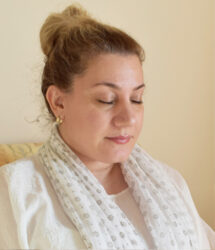My Recovery from Childhood Trauma and PTSD: A Social Worker’s Story

I think I’ve always had the ability to listen, to help people, which is one of the reasons I became a social worker in 2008. In my latest job, I was working at a pediatric hospital on the bone marrow transplant unit. Our young cancer patients lived in the hospital for weeks or months without getting discharged, so I developed close relationships with the children and their families. Bone marrow transplant is a high-risk treatment, and a lot of patients didn’t survive. That was devastating.
While I considered it a privilege to help these courageous children and families, I also struggled a lot. I didn’t have the energy to socialize, to do the things I wanted to do, and would watch senseless reality TV to try to forget what I’d seen at work. It was hard to witness such intense emotions and then come home to live your own life. I always felt tired or overwhelmed.
In addition to the emotional challenges associated with my job, I suffered from PTSD due to childhood trauma, and would often get triggered into anger or a frozen state.
All that changed three years ago when I heard about Ayurveda, a natural system of health care, on The Dr. Oz Show. As a result, I consulted with an Ayurvedic practitioner in Chicago. Perceiving my high stress levels, she said, “You really should do the Transcendental Meditation technique.”
Initially, the word “meditation” didn’t sound appealing. The only meditation I had heard about was mindfulness meditation, and I thought that observing my thoughts seemed pointless. At that point I didn’t know that TM was completely different.
Yet there was a strong feeling that kept telling me I really needed this. In fact, my strong gut feeling was that it would somehow save my life.
So I decided to attend the free introductory lecture on TM and hear what they had to say. From the moment I met my TM teacher, Mary Murphy, and her husband, Jeff, I felt this vibrant, loving energy. I thought, “I want what they have.” Two weeks later I learned TM and two friends started with me too.
I immediately noticed changes. On the day I was scheduled to learn TM, my dog was sick with pancreatitis, and was being treated with fluids and medication. When I arrived for my private instruction, I was feeling highly anxious and worried. After my first meditation, I returned home and gave my dog the care he needed, but I felt calm. And my dog was calmer too.
The next day, even though my dog was still very sick, I practiced my meditation as I’d been instructed, morning and evening, and I felt better than ever. The word I used to describe my mental state was “bliss”—not a word that would have come to mind before starting TM! I realized that I was feeling bliss in a situation that would normally be pretty stressful to me.
Since then, I have never missed a meditation and don’t ever plan to. Over the next year, I found myself reacting to stressful moments with less and less anger and fear. If a situation triggered me, it wasn’t so intense. TM has allowed my negative feelings to come and go more quickly, and it keeps me from getting stuck in traumatic memories like I did before.
I think the biggest change was the surge of love and forgiveness I felt toward the people in my life who had caused me harm. Before TM, I thought I would feel angry for the rest of my life.
But just a little while after I started meditating, I began to feel a deep love and connection to all the people around me. Relationships that were previously broken, damaged, or strained, were now filled with love and happiness. I thought, “What is going on?”
Years ago I didn’t care if those I felt resentment toward fell off the earth. I felt like they deserved it. Now I want them to learn TM, because I feel they deserve to live a happy, blissful life. We all do. This new feeling of gratitude and forgiveness is really big for me.
I would sometimes go on a TM retreat for the weekend. I’d come into work all rested and my co-workers would ask, “Are you on drugs? You look so happy.”
So work was easier, and I liked helping children to grow and heal and overcome obstacles. Yet as time passed, my gut was telling me that there was a better way to help. I also felt that I had been
extremely fortunate to do my own healing, and I wanted to share this amazing technique with others.
That thought has propelled me forward to a new phase of my career. Right now I’m a graduate student and I plan to attend the TM Teacher Training course next year. Because I really love working with kids, my goal is to teach TM to kids who need it most—kids in the foster care system, for instance, or kids with cancer and their families. These are at-risk, vulnerable people who need meditation to help them lessen the stress and experience more joy, comfort and healing.
I also see TM as a really important tool for healthcare workers.
As a social worker, one of my jobs was to provide support to the nursing staff. Some of the nurses were so young, right out of college, and hadn’t yet developed the skills to handle the emotions of the families. Naturally, they were focused on refining the high skill level needed to take care of these patients. In a unit where the children are so sick, parents understandably become frightened and frustrated, but when they lose control they often take it out on the nurses. And in today’s healthcare world, nurses are also facing stressful workplace conditions such as long hours, larger patient loads, shiftwork, poor communication, inadequate reward systems, interpersonal conflict and insufficient resources.
As a result, nurses suffer higher stress levels than any other profession. Research shows that TM helps nurses prevent burnout, compassion fatigue and overall stress. TM certainly helped me as a social worker, on the job and in my personal life. Now I hope to share this life-changing practice with social workers and other healthcare professionals.





